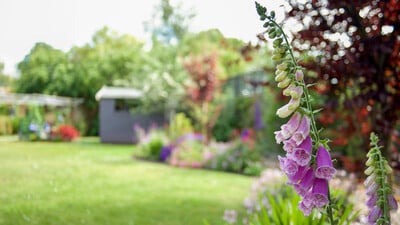What causes a garden to become waterlogged?
While heavy rainfall can cause soil to become temporarily saturated, under normal circumstances this should disperse quickly once the weather turns dry again. If it doesn’t, it’s time to look at other possible causes.
Longstanding causes of poor garden drainage
The location of a garden may make it more vulnerable to flooding; for example, if it is next to a watercourse or in a valley. The composition of the soil may also impede its ability to drain efficiently, with heavy clay soil acting as a barrier to drainage. A high groundwater table will also exacerbate the problem during rainy seasons. Waterlogging and flooding due to these causes are more likely to have occurred many times over a long period.
New causes of poor garden drainage
If poor garden drainage is a relatively recent event, it may be the result of one of many factors, or even a combination of them.
Over time, soil that has become compacted by machinery or even foot traffic will drain less efficiently. Laying non-porous hard landscaping materials such as paving over soil will also reduce the ground’s ability to absorb water. Slight damage to an underground water supply pipe can also saturate soil long before a more significant fracture makes it visible.
Some causes of poor drainage occur beyond the limits of the garden so if you are trying to trace the cause, be prepared to look outside the box hedge, so to speak. Have there been any changes to the immediate area?
Has there been any recent building in your neighbourhood? Construction of buildings and roads on any previously undeveloped land will reduce its ability to absorb rainfall and may result in run-off onto your property.
A new swimming pool in a neighbour’s garden will reduce the amount of water their plot can absorb and if installed incorrectly, could be leaking water into the soil.
Has a nearby pond been recently filled in? If it has been acting as a natural soakaway for the area, the water it once held needs to go somewhere and could be going into your garden.
Are there any natural watercourses such as streams and ditches that have become overgrown or blocked with rubbish so they can’t drain water from the area?
Why is poor drainage bad for gardens?
Long-term soil saturation can have a detrimental effect on the plants in your garden. Saturated soil reduces the amount of oxygen getting to their roots, suffocating them and causing root rot. This fungal disease causes wilting, yellowing and eventual death of the plant. Other pests and diseases also thrive in waterlogged soil. Excessive water in the soil leaches away essential nutrients, preventing the roots from absorbing them, while ground compacted by saturation makes it hard for roots to penetrate the soil.
But it isn’t only your plants that will suffer. Quite apart from the unsightly look of a waterlogged garden, poor drainage can lead to water stagnation, creating foul odours and a breeding ground for mosquitos and other insects.
How can poor drainage be fixed?
The solution to poor drainage will of course depend on the cause. Leaking water pipes can be repaired and blocked waterways can be cleared relatively easily, but if the cause is more complex a different approach will be needed.
If you have sufficient space, planting water-loving trees such as willows can help reduce the amount of saturation in the soil. Excavating a pond may create a natural catchment area for rainwater runoff. Replacing hard landscaped areas such as patios and driveways with gravel will allow water to soak into a wider area of soil. Aerating or applying dressing to lawns and spreading mulch on borders can also help.
If the problem is too severe for these measures or you want a solution that has less visual impact on the garden, a land drain may be a better option. This is a system of perforated plastic pipes, installed underneath your garden and acting as a rapid conduit to drain water from the soil. As rainwater passes through the soil it enters the pipes through the perforations and is quickly drained from the area, either into a stormwater drain or a nearby watercourse. If another section of the plot has better-draining soil, the land drain can be connected to a soakaway to release the rainwater into this soil.
Channel drains can also be used similarly to remove rainwater from non-porous surfaces such as patios and driveways without significant changes to their appearance.
We hope you have found this information helpful and interesting. If you have any further questions you are always welcome to call the friendly team of drainage experts at Drainfast on 01420 555600 or email [email protected].
Also, look out for more articles in our ongoing series of blog posts, bringing you useful information, insights, guides and tips on all things drainage!

Written by
Vicki James
Sales & Marketing Coordinator
Vicki is a vital part of the marketing team; from reporting to copywriting, she ensures we complete projects on time.

